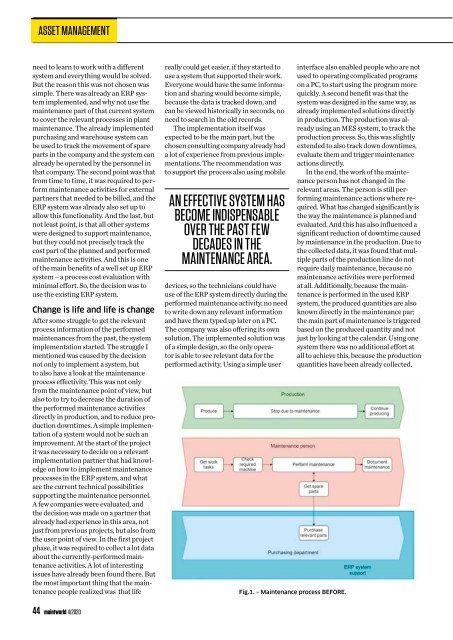Maintworld Magazine 4/2020
- maintenance & asset management
- maintenance & asset management
You also want an ePaper? Increase the reach of your titles
YUMPU automatically turns print PDFs into web optimized ePapers that Google loves.
ASSET MANAGEMENT<br />
need to learn to work with a different<br />
system and everything would be solved.<br />
But the reason this was not chosen was<br />
simple. There was already an ERP system<br />
implemented, and why not use the<br />
maintenance part of that current system<br />
to cover the relevant processes in plant<br />
maintenance. The already implemented<br />
purchasing and warehouse system can<br />
be used to track the movement of spare<br />
parts in the company and the system can<br />
already be operated by the personnel in<br />
that company. The second point was that<br />
from time to time, it was required to perform<br />
maintenance activities for external<br />
partners that needed to be billed, and the<br />
ERP system was already also set up to<br />
allow this functionality. And the last, but<br />
not least point, is that all other systems<br />
were designed to support maintenance,<br />
but they could not precisely track the<br />
cost part of the planned and performed<br />
maintenance activities. And this is one<br />
of the main benefits of a well set up ERP<br />
system – a process cost evaluation with<br />
minimal effort. So, the decision was to<br />
use the existing ERP system.<br />
Change is life and life is change<br />
After some struggle to get the relevant<br />
process information of the performed<br />
maintenances from the past, the system<br />
implementation started. The struggle I<br />
mentioned was caused by the decision<br />
not only to implement a system, but<br />
to also have a look at the maintenance<br />
process effectivity. This was not only<br />
from the maintenance point of view, but<br />
also to to try to decrease the duration of<br />
the performed maintenance activities<br />
directly in production, and to reduce production<br />
downtimes. A simple implementation<br />
of a system would not be such an<br />
improvement. At the start of the project<br />
it was necessary to decide on a relevant<br />
implementation partner that had knowledge<br />
on how to implement maintenance<br />
processes in the ERP system, and what<br />
are the current technical possibilities<br />
supporting the maintenance personnel.<br />
A few companies were evaluated, and<br />
the decision was made on a partner that<br />
already had experience in this area, not<br />
just from previous projects, but also from<br />
the user point of view. In the first project<br />
phase, it was required to collect a lot data<br />
about the currently-performed maintenance<br />
activities. A lot of interesting<br />
issues have already been found there. But<br />
the most important thing that the maintenance<br />
people realized was that life<br />
really could get easier, if they started to<br />
use a system that supported their work.<br />
Everyone would have the same information<br />
and sharing would become simple,<br />
because the data is tracked down, and<br />
can be viewed historically in seconds, no<br />
need to search in the old records.<br />
The implementation itself was<br />
expected to be the main part, but the<br />
chosen consulting company already had<br />
a lot of experience from previous implementations.<br />
The recommendation was<br />
to support the process also using mobile<br />
AN EFFECTIVE SYSTEM HAS<br />
BECOME INDISPENSABLE<br />
OVER THE PAST FEW<br />
DECADES IN THE<br />
MAINTENANCE AREA.<br />
devices, so the technicians could have<br />
use of the ERP system directly during the<br />
performed maintenance activity, no need<br />
to write down any relevant information<br />
and have them typed up later on a PC.<br />
The company was also offering its own<br />
solution. The implemented solution was<br />
of a simple design, so the only operator<br />
is able to see relevant data for the<br />
performed activity. Using a simple user<br />
Fig.1. – Maintenance process BEFORE.<br />
interface also enabled people who are not<br />
used to operating complicated programs<br />
on a PC, to start using the program more<br />
quickly. A second benefit was that the<br />
system was designed in the same way, as<br />
already implemented solutions directly<br />
in production. The production was already<br />
using an MES system, to track the<br />
production process. So, this was slightly<br />
extended to also track down downtimes,<br />
evaluate them and trigger maintenance<br />
actions directly.<br />
In the end, the work of the maintenance<br />
person has not changed in the<br />
relevant areas. The person is still performing<br />
maintenance actions where required.<br />
What has changed significantly is<br />
the way the maintenance is planned and<br />
evaluated. And this has also influenced a<br />
significant reduction of downtime caused<br />
by maintenance in the production. Due to<br />
the collected data, it was found that multiple<br />
parts of the production line do not<br />
require daily maintenance, because no<br />
maintenance activities were performed<br />
at all. Additionally, because the maintenance<br />
is performed in the used ERP<br />
system, the produced quantities are also<br />
known directly in the maintenance par;<br />
the main part of maintenance is triggered<br />
based on the produced quantity and not<br />
just by looking at the calendar. Using one<br />
system there was no additional effort at<br />
all to achieve this, because the production<br />
quantities have been already collected.<br />
44 maintworld 4/<strong>2020</strong>

















